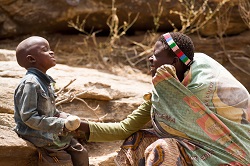The effect of culture on infants’ development of communication
Tanzania’s Hadza represent a particularly interesting cultural community, living in conditions that resemble those of our ancestors. The project Hadza communication took an interdisciplinary approach to study infants’ verbal and non-verbal interactions with their social environment. Innovating for modern anthropological studies “We developed a miniaturised data collection device, the multi-modal interaction recorder for children (MIRC), which was used to collect physiological data (heart rate), audio recordings and the distance of important caregivers from the infant,” notes Dr Monika Abels, project research fellow. Infants wore the device for extended periods of time, without it interfering in their everyday activities. “To our knowledge, this is the first device combining these data streams,” says Dr Abels. Its innovation lies in its immunity to observer bias and fatigue. The automatic measurement of distances offers an interesting alternative to the traditional observation of distances approach frequently employed by anthropologists. Common thread in development of communication through the ages Research revealed that Hadza infants have similar interaction experiences as infants in other communities that have previously been described more extensively. Dr Abels cites an example: “The most frequent gestures they produce are show/offer, point, request and pick me up gestures. This key finding “seems to strengthen the perspective that these gestures may be part of a universal human gestural repertoire.” Other important findings show that an infant’s state has bearing on interactional patterns – “For instance, infants make requesting gestures and pick me up gestures more frequently when they are distressed than when they are not distressed and correspondingly caregivers produce more offering and approach gestures.” Dr Abels further notes that language addressing infants varies according to the livelihood patterns of the camps where they reside – there being marked differences between infants in remote camps and those in transition or relying on tourism. In the latter, infants more frequently hear imperatives rather than being addressed with vocatives. “While imperatives can help infants participate in their interactional partners’ activities, they can also be understood as a marker of hierarchical relationships that are uncharacteristic of traditional, egalitarian hunter-gatherer communities.” The project’s most important finding is that the Hadza society is changing as the basis for their lifestyle is disappearing – a phenomenon accepted to hold true for hunter-gatherer communities in general. This has far-reaching consequences for children’s experiences and development, including communication. Communicating key findings on… communication The MIRC(opens in new window) was presented at the 2017 SRCD Biennial Meeting in Austin, Texas. Results to date were also presented at the ‘14th International Congress for the Study of Child Language’ in Lyon, France and at the workshop ‘Many Paths to Language (MPaL)’, hosted in Nijmegen, the Netherlands. Another presentation is planned at the Evolang Conference XII(opens in new window) in Torun, Poland in April 2018. Other dissemination activities include presenting project work to the Hadza community, collaboration with a nurse servicing the community, and cooperating with the Tanzanian National Institute for Medical Research, which informs Tanzanian policy decisions. In Europe, Hadza communication has presented its work to interested members of the public at a midwife’s practice, with similar activities planned for the near future. Although the project has officially ended, Dr Abels says there are plans to use the MIRC to collect data in other cultural communities so patterns can be compared across cultures. “Archival film material of several communities over a time span of several decades can be utilised to answer the question whether the pattern observed in the Hadza on livelihood and language addressed at infants is a pattern that can be found in other changing communities as well,” Dr Abels concludes.







